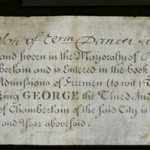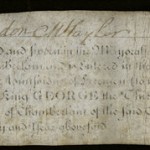
In America, children are raised to believe that all men are created equal. This accepted equality spurs unalienable rights such as life, liberty, and the pursuit of happiness. Even before the Declaration of Independence was signed in 1776, Americans have wanted and have been willing to fight for their freedom. While Americans fought for unity and independence, citizens of Great Britain were earning their freedom in the form of a long, rolled piece of paper called a Freedom of the City certificate.
The Ransom Center houses two Freedom of the City certificates in the John B. Dancer collection. One belonged to Michael Dancer. According to the certificate, Michael Dancer was the son of W. M. Dancer, who apprenticed for many years before being granted his freedom on September 3, 1776. Freedom of the City certificates were typically about 24 inches long by 5 inches high. The narrow pieces of paper are creased vertically in many places, implying that the certificate was kept rolled up for a long period. Like a modern-day passport or driver’s license, a freedom certificate would have been carried on one’s person to prove identity and citizenship. Most freedmen were given a casket—normally a long narrow tube—upon receiving their freedom in order to carry their certificate safely and conveniently.
In London, freedom had to be earned before it could be granted until 1832. Starting in the Middle Ages, a man was considered a “freeman” as long as he was not ruled over by any feudal lord. If he was a peasant or a serf, his freedom was in the hands of the lord of his land. A freeman, though, enjoyed such privileges as the right to earn money and to own land. At the beginning of the Middle Ages, freemen were few and far between. Only lords enjoyed property ownership and income until England experienced industrial progression in the late eighteenth century. The influx of industry created a middle class who were no longer agrarian peasants, but not rich enough to become lords. Such people lived in cities, often practiced specialized trades, and were commonly referred to as townsmen. Towns were often under the rule of the monarchy instead of a local feudal lord, and thus townsmen could be granted Freedom of the City.
The granting of Freedom of the City, particularly in London, is one of the oldest surviving traditional ceremonies still in existence and practice today. The first freedom is believed to have been presented as early as 1237. These early freedom ceremonies held great social importance because they affirmed that the recipient would enjoy privileges such as the right to trade and protection within the town. Until 1835, Freedom of the City members were the only people within London who could legally exercise a trade within city limits.
Members were presented with a notarized certificate proclaiming their freedom and a book titled Rules for the Conduct of Life, which was intended to guide them in their life as freemen. While providing many basic laws and recommended codes of conduct, the book also outlined several interesting freedoms available only to freemen. For example, the book notes freemen have the right to herd sheep over the London Bridge, go about the city with a drawn sword, and—if convicted of a capital offense—to be hung with a silken rope. Other ascribed privileges are said to include the right to be married in St. Paul’s cathedral, to be buried in the city, and to be drunk and disorderly without fear of arrest.
Today, Freedom of the City of London is granted in two forms. Though few of the practical reasons for obtaining Freedom of the City remain, the certificate continues to be a unique part of English history. As of 1996, the honor is open to anyone around the world who has been nominated and maintains good character. Each year about 1,800 people apply to become freemen. The second way of becoming a freeman is by being granted Honorary Freedom of the City of London. The City of London presents individuals who have made significant impact in their field of work or who have done extraordinary things for the city with this honor. Even today, many citizens of London continue to join Michael Dancer as freemen.
Please click on thumbnails for larger images.
Image: Certificate dated September 3, 1776, admitting Michael Dancer to freedom of the city of London.

